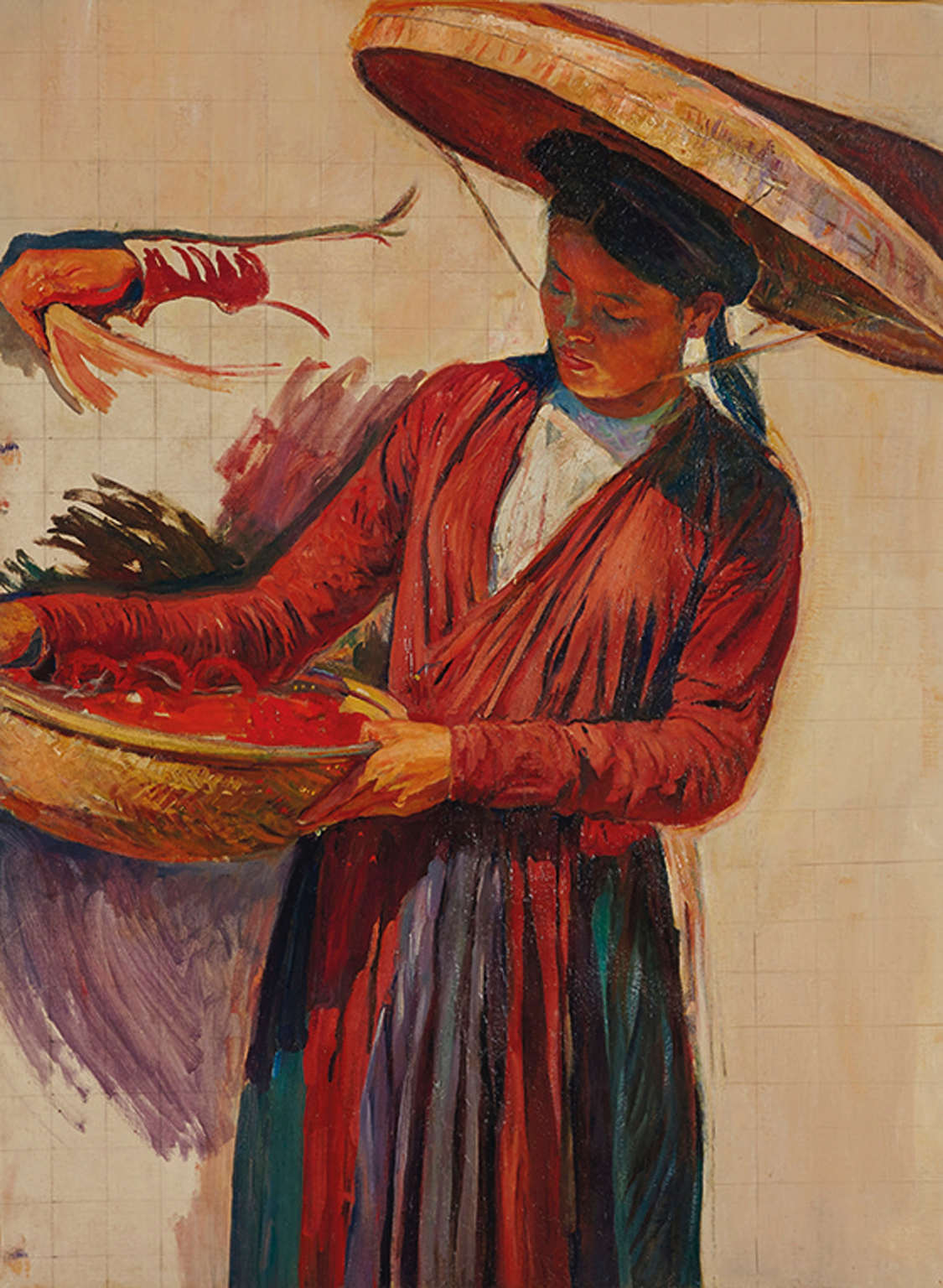
Victor Tardieu (France, 1870-1937)
La Tonkinoise Au Panier (Tonkin Woman with Basket)
oil on canvas
108 x 80 cm. (42 1/2 x 31 1/2 in.)
Painted in 1923
La Métropole: la science dispense au peuple d’Annam ses bienfaits, Portrait de femme à l'éventail, Maternities, La Vaccination, La Tonkinoise, and La Vietnamienne à l'Enfant are Victor Tardieu's subjects defined for the major fresco 160m2 to compose an ode on progress.
On the 2nd of February 1921, Victor Tardieu arrived in Hanoi probably with no idea of what lay ahead of him. As a talented painter, recently graduated from the academy Les Beaux-Arts de Paris and already known for some of his work, he received the Indochina Prize from the French government which allowed him free travel to Vietnam, and accommodation with travelling costs included in return for describing the beauty and the competence of this then-little known colony. The order of a large fresco for the University of Indochina (then under construction) marked a turning point for Tardieu personally, as well as for Vietnamese painting. To fulfill this order he had to extend his stay over the year planned as to await the end of the university's construction.
In 1921, Tardieu was not yet aware of the important role he was about to play in Vietnamese visual art of the 20th century. However on 24th October 1924 he founded the art school L'Ecole des Beaux-Arts in Hanoi which would soon attract some of the most famous painters Vietnam was to know: Le Pho, Mai Thu, Vu Cao Dam as well as Nguyen Phan Chanh, Nguyen Gia Tri and To Ngoc Van, just to name a few. Through their work, they all testified to the affection and respect for Tardieu's teaching.
Through Tardieu's humanist philosophy, the large fresco for the University of Indochina magnified the French effort in Vietnam, depicting an almost idyllic relationship based on mutual respect. To achieve this (Fig 1.), Tardieu painted numerous characters meant to represent the strength of both civilizations. Tardieu advocated collaboration over confrontation and through evoking the rurality of Vietnam in his works, also conjured the essence of its culture, land and the peasants who incarnate it. Our lady peasant, "La
Tonkinoise" wears her traditional hat and keeps her grace despite the harshness of the task. Her left hand, at the same time beautiful and firm, shows and symbolizes the Vietnamese women's strength as we know it since the sisters Trung. This lady, coming to sell her products to the market shows femininity and unceasing elegance.
Tardieu first created a series of smaller paintings, dated between 1922 and 1924, depicting the main characters used for the fresco. La Tonkinoise, along with Maternities, La Vaccination and La Vietnamienne à l'Enfant are Victor Tardieu's subjects defined for the major fresco 160m2 to compose an ode on progress. Some commentators – superficial – found in this work what they will call a "colonial" message. However, it is easy to distinguish on the eminently Vietnamese Cong Tam Quan portal, on two columns, the following sentences written in Chinese: "The elites are the essence of the country. The university is the foundation of education." Further, at the bottom of the work, a Latin sentence is inscribed: "Alma mater, ex te nobis, dignitas, libertas, Felicitas" (supreme mother, it is from you that we receive dignity, liberty and happiness). From this immense composition, an ode to education and progress, the image of love, femininity and Vietnamese among other themes only shows Tardieu’s love for Vietnam.
Tardieu worked on this large fresco in three stages. First, he drew many charcoal sketches on paper to describe with precision the themes chosen and to imagine them in the final fresco. After which he painted the different themes with oils on canvas matching the final scale. Finally, Tardieu painted the scene on to the foundation of the large fresco in the University.
This present painting is the first version on canvas. It conveys the energy and freshness of a new painting and Tardieu's talent is expressed with panache and class. Exoticism is minimized here. On the contrary, he kept close to the everyday reality (hat, clothes, basket) of Vietnamese women. He painted to describe and relate, and not to fantasize, unlike other Orientalists.
La Tonkinoise is a Tardieu's masterpiece. It shows the depth and the quality of the subject and the quality of the painter's technique (see the grid for example). This ideal and this technique together are the cornerstones of Tardieu's success in Vietnam.










